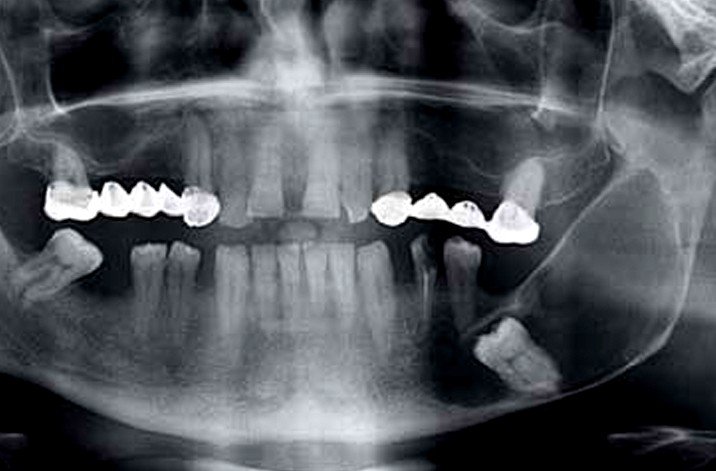Dentigerous cyst
What is a Dentigerous cyst?
This is a type of cyst that normally surrounds the crown of your impacted tooth. It is noticed due to the accumulation of fluid that takes place between the layer referred to as reduced enamel epithelium and the enamel surface of a tooth. This will lead to what looks like a cyst. The crown is found within the lumen of the cyst and is almost always seen in permanent teeth. It is rare to see them in deciduous teeth, which are your temporary, or baby, teeth. A dentigerous cyst falls under the category of developmental odontogenic cysts. The dentigerous cyst is believed to account for one-fifth of all jaw cysts found and is also the second most common of all developmental odontogenic cysts.
You will find this type of cyst it is normally associated with the crown of your unerupted or impacted tooth. It is normally seen in the area of the mandibular and maxillary third molars. Sometimes it may be seen in your upper canine teeth, especially if they are impacted. It may also be found in supernumerary teeth, which are the extra teeth you can have in your mouth. You will normally find dentigerous cysts in people during their twenties and thirties with men having more of a chance of developing them than women. They are usually solitary cysts. With other medical syndromes you may see multiple or bilateral cysts. It is also referred to as a follicular cyst and is usually non-cancerous.
Symptoms
A dentigerous cyst does have the ability to become aggressive and if they become larger in size it could lead to bone expansion. This can lead to a visible swelling and then to facial asymmetry, which is a medical condition in which the right side of a person’s face does not match the left side. It can also increase into a size that may displace the adjacent teeth eventually, leading to discomfort and pain that can be bad. With a severe cyst it can take up the whole angle of your mandible, causing your mandible to be hollowed out. This could make your mandible compromised and weak.
If the dentigerous cyst becomes large in size where it does not cause any symptoms this means that it is asymptomatic, which means there are no symptoms. Unless the cyst becomes infected there will be no pain.
Causes
At this time it is not known exactly what leads to this type of fluid accumulation that eventually results in the formation of a cyst. Some feel that the reason that a person develops a dentigerous cyst is due to the presence of teeth that have not erupted, pulp necrosis, and primary tooth trauma. These teeth that have not erupted include your wisdom teeth and upper jaw canines.
Diagnosis
They symptoms of a dentigerous cyst are what play a critical role in the diagnosis of this type of cyst. Normally it will be diagnosed with an x-ray. The area between the tooth and the cyst lining will normally be larger than five millimeters. Discovering a dentigerous cyst is usually by accident when they are doing routine dental x-rays.
Treatment
The only way to take care of a dentigerous cyst is with surgical intervention as there is no medicine that will help to get rid of it. If they remove the entire cystic lining and cyst the chances of recurrence is minimal. To avoid any complications you should have it diagnosed and treated properly.
Surgery
- Small dentigerous cyst – this would involve the surgical removal of the entire cystic lining, cyst, and the impacted tooth
- Large dentigerous cyst – if there is a large amount of bone loss the treatment would be marsupialization or surgical drainage may be necessary. Marsupialization means to cut a slit into a cyst to let it drain. It is not a good idea to surgically remove the large cyst because of the risk of fracturing your jaw
Complications
- Developing an ameloblastoma, which is a rare benign tumor that develops in your jaw near your molars
- Developing an epidermoid carcinoma, which is a non-small-cell type of lung cancer that develops from the cells that line the inside of your lungs
- Risk of a large jaw fracture
Dentigerous cyst Pictures

